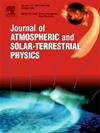太阳能汽车沿道路运动的仿真和可视化
IF 1.9
4区 地球科学
Q3 GEOCHEMISTRY & GEOPHYSICS
Journal of Atmospheric and Solar-Terrestrial Physics
Pub Date : 2025-04-19
DOI:10.1016/j.jastp.2025.106524
引用次数: 0
摘要
建立了太阳能汽车在任意不平路面上运动仿真的数学模型。该模型由两部分组成。首先是“落在太阳能汽车面板上的太阳辐射的数学模型”,它确定了在任何时刻和道路上任何一点落在面板上的太阳能的量。二是“太阳能汽车运动的数学模型”,在考虑所有作用在汽车上的主要作用力的情况下,通过求解运动微分方程来确定运动规律;即:驱动、重力、反作用力和阻力。该模型模拟的数据已被用于创建基于arcgis的汽车沿着选定道路运动的三维可视化。所建立的模型可用于评价所选太阳能汽车在不平坦路面上的性能,并可用于解决以下问题:1)汽车运动启动时间的最优选择,使行驶时间最短;ii)确定混合动力(光伏+蓄电池)汽车在不平路面应保持的最优车速;Iii)确定汽车到达需要大量太阳辐射或充足电的蓄能器的山口的瞬间;4)确定触发蓄电池及其充电的适当时机等。同时,该模型可以估算出PV板在选定的高速公路上行驶过程中所收获的太阳能量。这种能量主要取决于地理位置、季节、天气条件、道路地形(轨迹)和汽车速度。本文章由计算机程序翻译,如有差异,请以英文原文为准。

Simulation and visualizations of solar car motion along the road
A mathematical model for the simulation of the motion of a solar car along the arbitrary uneven road has been developed. This model consists of two parts. The first is the “mathematical model of solar radiation falling onto the panel of the solar car” that determines the amount of solar energy falling onto the panel at any instant of time and at any point of the road. The second is the “mathematical model of the motion of the solar car” that determines the law of motion by solving the differential equation of motion while taking into account all the main forces acting on the car; namely: driving, gravity, reaction, and resistance. The model-simulated data has been used to create ArcGIS-based 3D visualization of car motion along the chosen roads.
The model developed here can be used to evaluate the performance of chosen type of solar car on uneven road and can serve for the solution of various problems such as: i) optimal choice of car motion starting time to minimize travelling time; ii) determination of the optimal speed that should be maintained along the uneven road for hybrid (PV + accumulator) cars; iii) determination of the instants of time when car will reach the mountain passes where a huge amount of solar radiation or sufficiently charged accumulators, are needed; iv) to determine the proper instants of time for triggering the accumulator and its charging, etc. At the same time, the model allows to estimate the amount of solar energy harvested by PV panel during the motion on the chosen highway. This energy depends mainly on the geographical location, the season, the weather conditions, the topography of the road (trajectory) and car speed.
求助全文
通过发布文献求助,成功后即可免费获取论文全文。
去求助
来源期刊

Journal of Atmospheric and Solar-Terrestrial Physics
地学-地球化学与地球物理
CiteScore
4.10
自引率
5.30%
发文量
95
审稿时长
6 months
期刊介绍:
The Journal of Atmospheric and Solar-Terrestrial Physics (JASTP) is an international journal concerned with the inter-disciplinary science of the Earth''s atmospheric and space environment, especially the highly varied and highly variable physical phenomena that occur in this natural laboratory and the processes that couple them.
The journal covers the physical processes operating in the troposphere, stratosphere, mesosphere, thermosphere, ionosphere, magnetosphere, the Sun, interplanetary medium, and heliosphere. Phenomena occurring in other "spheres", solar influences on climate, and supporting laboratory measurements are also considered. The journal deals especially with the coupling between the different regions.
Solar flares, coronal mass ejections, and other energetic events on the Sun create interesting and important perturbations in the near-Earth space environment. The physics of such "space weather" is central to the Journal of Atmospheric and Solar-Terrestrial Physics and the journal welcomes papers that lead in the direction of a predictive understanding of the coupled system. Regarding the upper atmosphere, the subjects of aeronomy, geomagnetism and geoelectricity, auroral phenomena, radio wave propagation, and plasma instabilities, are examples within the broad field of solar-terrestrial physics which emphasise the energy exchange between the solar wind, the magnetospheric and ionospheric plasmas, and the neutral gas. In the lower atmosphere, topics covered range from mesoscale to global scale dynamics, to atmospheric electricity, lightning and its effects, and to anthropogenic changes.
 求助内容:
求助内容: 应助结果提醒方式:
应助结果提醒方式:


